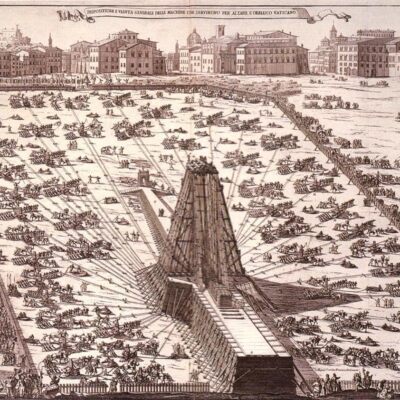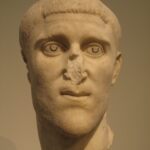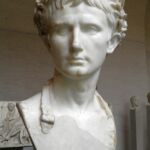What are we talking about? Of course, probably the largest monolith ever brought and placed in Rome. The obelisk of the Egyptian pharaoh Thutmose III, which was ordered to be placed on the Circus Maximus by Emperor Constantius II.
THE HIGHEST: Of all the obelisks erected in Rome, none could compare with this one. The obelisk of Thutmose III was over 32 meters high! That’s about the size of eight- or nine-story buildings today!
THE HEAVYEST: How much it originally weighed is not entirely clear. But various publications usually mention a staggering mass of 360 to 450 tons! 450 tons is almost as much as three Boeing 747s, commonly known as JumboJet!
THE OLDEST: when it was erected in Rome, almost eighteen centuries had passed since it was carved from the bedrock! For Emperor Constantius II, Pharaoh Thutmose III was an even more ancient figure than Constantius II for us!
Let’s start our story in Egypt. Pharaoh Thutmose III was an extraordinary person. He became King of Egypt at the age of only 2! It was his father, Thutmose II, who took care of his son’s future. When he was still a toddler unable to stand on his own legs, during the holy procession of the god Amun in Thebes, Thutmose II made sure that the statue of the god stopped for a moment next to the boy’s cradle. In this way, God himself allegedly appointed him as heir to the throne. Thutmose II died shortly afterward. As a two-year-old, Thutmose III could not actually rule Egypt, so his aunt, whom history remembers as Queen Hatshepsut, did so on his behalf. Hatshepsut pushed Thutmose III into the shadow and declared herself pharaoh, and since a female pharaoh was the exception rather than the rule in Egypt, she began to present herself as a man. Thutmose III had to wait 20 years to take over from Hatshepsut. But maybe it was worth the wait? He went down in Egyptian history as one of the country’s greatest rulers. It was his military victories that were commemorated by two twin obelisks – including the one shown in the attached photo.
But let’s get back to Rome. Since the reign of Augustus, who definitively conquered Egypt and incorporated it into the Empire, Egyptian antiquities have returned to fashion from time to time. The Romans had great admiration for the Egyptian civilization, which was already considered ancient in their times. Obelisks imported from Egypt were a manifestation of this fascination. Augustus had one of such obelisks placed on the spin of the Circus Maximus, another on the Campus Martius, and another one brought to Rome by Caligula and placed on the spin of the Vatican Hippodrome. Bringing such large monoliths to Rome required a huge organizational effort, so it was quite an event.
When Emperor Constantius II reigned in Rome, Rome’s glory years were already behind it. It was already the second half of the 4th century AD, and the Empire was becoming more and more Christian in character. Constantius II visited the nominal capital of the Western Empire only once – in 357. From the account of his contemporary historian Ammianus Marcellinus, we know that Constantius was enchanted by what he saw in Rome. Looking at its monumental architecture, he was said to have been stunned by its magnificence: “he tried to comprehend in his mind its enormous dimensions – too great for any mortal to describe, and rendering in vain any attempt to equal them.” Constantius, who had previously planned to build an impressive new building in Rome, was discouraged when he saw what his predecessors had built in Rome.
But despite this, Constantius ultimately left some trace of himself in Rome: the obelisk I am writing about today. Two twin obelisks over 32 meters high stood in the temple of Amun-Ra in the former capital of Egypt – Thebes. One of them was planned to be transported to Rome by Augustus himself, but the undertaking turned out to be technically too demanding. More than three centuries later, Constantine the Great returned to this idea and managed to dismantle both obelisks of Thutmose III and float them to Alexandria, where they remained for many years. Only Constantius II sent one of them to Rome and set up the Circus Maximus, next to the one previously brought by Augustus. The second one later went to Constantinople – the new capital of the Empire.
When describing the history of the obelisk of Thutmose III in Rome, it is easy to say: remove the obelisk from the temple of Amun, transport it to Rome and place it in the Great Circus. That’s only thirteen words! But in reality, this undertaking was a huge feat and is worth discussing in more detail.
The dismantling of the obelisk itself is something extraordinary – it stood not in an open space, but in the middle of the temple complex of Amun in Thebes, where the possibilities of maneuvering such a huge monolith were very limited. The Romans didn’t bother – to transport the obelisk, they demolished part of the sanctuary. Interestingly, archaeologists discovered strange depressions near the temple – some believe that it was the enormous weight of the obelisk dragged by the Romans that caused the ground to collapse and the stone slabs to deform along the route of its transport. It is difficult to imagine a large barge that must have been able to carry a colossal weight of several hundred tons. And yet they succeeded: not only did they successfully place the obelisk in a horizontal position without damaging it, but they also moved it on wooden rollers over the Nile and floated it to Alexandria.
But the most interesting thing comes next. The mentioned Ammianus Marcellinus writes as follows:
And because sycophants, after their fashion, kept puffing up Constantius and endlessly dinning it into his ears that, whereas Octavius Augustus had brought over two obelisks from the city of Heliopolis in Egypt, one of which was set up in the Circus Maximus, the other in the Campus Martius, as for this one recently brought in, he neither ventured to meddle with it nor move it, overawed by the difficulties caused by its size — let me inform those who do not know it that that early emperor, after bringing over several obelisks, passed by this one and left it untouched because it was consecrated as a special gift to the Sun God, and because being placed in the sacred part of his sumptuous temple, which might not be profaned, there it towered aloft like the peak of the world. But Constantine, making little account of that, tore the huge mass from its foundations; and since he rightly thought he was committing no sacrilege if he took this marvel from one temple and consecrated it at Rome, that is to say, in the temple of the whole world, he let it lie for a long time, while the things necessary for its transfer were being provided. And when it had been conveyed down the channel of the Nile and landed at Alexandria, a ship of a size hitherto unknown was constructed, to be rowed by three hundred oarsmen. After these provisions, the aforesaid emperor departed this life and the urgency of the enterprise waned, but at last the obelisk was loaded on the ship, after long delay, and brought over the sea and up the channel of the Tiber, which seemed to fear that it could hardly forward over the difficulties of its outward course to the walls of its foster-child the gift which the almost unknown Nile had sent. But it was brought to the vicus Alexandri distant three miles from the city. There it was put on cradles and carefully drawn through the Ostian Gate and by the Piscina Publica and brought into the Circus Maximus. After this there remained only the raising, which it was thought could be accomplished only with great difficulty, perhaps not at all. But it was done in the following manner: to tall beams which were brought and raised on end (so that you would see a very grove of derricks) were fastened long and heavy ropes in the likeness of a manifold web hiding the sky with their excessive numbers. To these was attached that veritable mountain engraved over with written characters, and it was gradually drawn up on high through the empty air, and after hanging for a long time, while many thousand men turned wheels resembling millstones, it was finally placed in the middle of the circus
– Ammianus Marcellinus, Roman history, XVII.4.12-16
The technical aspect of bringing the obelisk to Rome is very interesting. Note that in order to get it to its destination, the barge with the monolith had to be pulled against the current of the Tiber. We know that the barges transporting goods from Ostia to Rome were pulled by oxen. It’s hard to imagine how many oxen would have to pull a weight of several hundred tons… From Ammianus’ account, it is worth noting a few facts: first, the place where the obelisk was unloaded near Rome. Note that it was not dragged to the port quay, but was unloaded earlier, south of the city, more or less in the vicinity of today’s Centrale Montemartini museum. Why did the Romans extend the land route so much? There are several reasons for this: it is possible that there was not enough room on the river port embankment at the Forum Boarium to maneuver the huge cargo. Or the obstacle could be the bridges on the Tiber, under which the huge barge could not fit. The unloading site was chosen not by accident: it was easiest to transport such a huge monolith pulled by ropes on rollers in a straight line. Navigating every turn in a densely built-up city was an additional difficulty. It so happens that at the point of unloading (as I mentioned – near Centrale Montemartini), Via Ostiensis reaches almost to the Tiber itself, and the route connecting this place with Circus Maximus is almost perfectly straight.
We shouldn’t imagine thousands of people pulling on the ropes. The Romans were more inventive. The obelisk moved slowly, pulled by ropes attached to large winches in which the power of human muscles was used more effectively. Each time the monolith moved a little, the entire machinery had to be dismantled and re-set a little further to raise the obelisk several dozen meters again. Ammianus compares windlasses to mills – our imagination suggests water mill wheels, but this is a wrong idea – we should have in our minds the image of stone millstones from Pompeii or Ostia, rotated in a horizontal position by the power of people or animals walking around.
Interestingly, the obelisk could probably only be entered into the Circus Maximus from thecarceres side (starting boxes). Why? For two reasons: because the gate on the semicircular south-eastern part of the hippodrome was probably too narrow to carry a huge load through it (not only the monolith itself, but also the arrangement of the rigging machinery needed to pull it). The scale of necessary demolitions around carceres was probably much smaller. The second reason is the obelisk of Augustus, which stood exactly in the middle of the Circus axis, so it would have to be avoided from the south-east. The route through carceres avoided this problem.
The mention of thousands of people who participated in the raising of the obelisk does not seem exaggerated. An idea of what human forces were needed for this is provided by a painting dating back to modern times, illustrating the moving of the “Caligula obelisk” to the square. Saint Peter. The information about the “rigging that covered the sky” is also reliable. The enormity of the scaffolding, capable of supporting a weight of several hundred tons, must have made a great impression on contemporaries.
Setting the obelisk of Thutmose III vertically on the spin of the Circus Maximus would have been a huge spectacle. The hippodrome was perfect for this – perhaps as many as three hundred thousand people could observe this fascinating spectacle, which was a display of imperial power and strength.
The obelisk erected by Constantius II was intended to outshine the achievements of his predecessors. It must be admitted that the goal was achieved. Never again (probably until modern times) was anyone dared to transport such a large object to Rome. Considering that in the times of Constantius the Empire was no longer as strong as before, the organizational effort put into erecting the obelisk still arouses great admiration. However, even such undertakings had only an image-related significance. Nothing could prevent the inevitable – the end of the Western Empire was fast approaching. People who, in their youth, could watch with their own eyes from the stands of the Circus Maximus the erection of the largest stone block ever brought to Rome, a few decades later witnessed their city being brought to its knees by the barbarians…
The obelisk of Thutmose III cracked and fell over. It was only reassembled and erected in the 16th century. But not in Circus Maximus anymore. Currently, it decorates the square near the Basilica of St. John in Lateran, which is why we call it the “Lateran obelisk”. And although it is 4 meters shorter than in the times of Constantius II, it still makes a huge impression.
As a side note: the twin obelisk of Thutmose III, dismantled at the same time as the one placed in Rome in the Circus Maximus, was less fortunate. It broke during transport to Constantinople. The largest piece was placed on the Bosphorus, but it is not as impressive as the Lateran obelisk.








